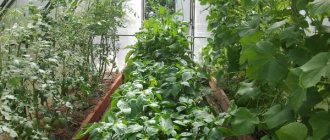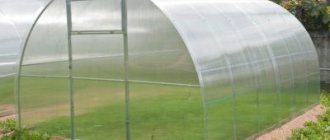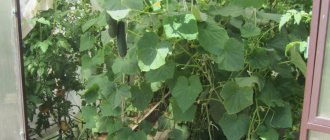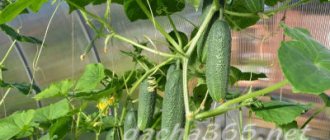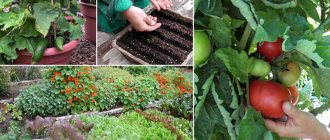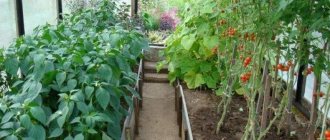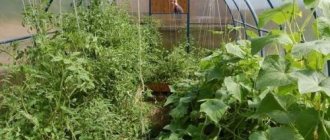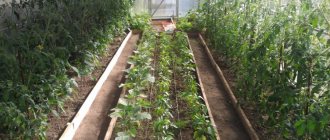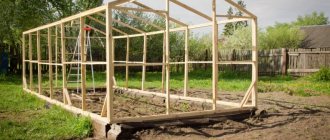The first mentions of mixed plantings came to us with the discovery of America by Columbus. Native American tribes used this method to protect shade-loving plants by planting crops with large leaves nearby to create shelter from the sun's rays.
In Russia, for a long time, the method was used only by individual amateur gardeners, so information about what to plant next to tomatoes is drawn mainly from Western literature and is very contradictory.
There is an opinion that tomato is a monoculture that does not tolerate neighbors, growing well only separately from other species. In fact, tomatoes get along well with garden crops in mixed plantings; it is important to choose the right accompanying plants.
Advantages of mixed plantings
In mixed plantings, each plant has its own important role. Tomato is the main crop. Accompanying plants or companion plants are planted next to it, the function of which is to provide a favorable environment for the growth of the tomato. Growing tomatoes with neighbors has a number of benefits.
- The area allocated for planting is used rationally. This is especially important for greenhouses and small plots of gardening partnerships;
- compacted plantings produce high yields of up to 20 kg per 1 m2;
- plants are less sick and damaged by pests;
- from one plot you can harvest vegetables from early spring until the onset of cold weather;
- soils are less depleted, since different crops absorb different substances from the fertile layer;
- symbiosis (useful interaction) occurs. Plants help each other. Some species repel pests, others loosen the soil or improve its composition.
Why it is necessary to consider the interaction of cultures
There is a whole field of science (allelopathy) that studies the interaction of plants in phytocenoses with each other. The influence can be both direct and indirect.
With close proximity of crops, a direct influence occurs during the release of chemicals (enzymes, organic acids, phenolic compounds, vitamins, sugars) by roots and volatile compounds by leaves.
These substances can have both positive and negative effects on neighbors, oppressing them, so it is necessary to carefully select crops that will grow in the same bed.
In addition to the chemical, there is a physical effect when plants can shade neighbors or create a protective barrier from the wind.
Indirect interaction occurs through the soil. Precursor plants change the composition of the soil, enriching or depleting it, compacting or loosening it, taking and introducing various elements into it. All this must be taken into account when planting tomatoes.
Basic rules for plant proximity
There are many subtle and elusive connections between plants that scientists will have to study for many years to come, but there are also general rules for the proximity of plants that allow all inhabitants of the garden bed to feel comfortable:
- plants with a shallow root system are planted together with crops that obtain nutrition from deep layers of soil in order to avoid competition for nutrients and water;
- crops must belong to different families; the absence of common diseases and pests increases the yield;
- it is important to choose plants that do not shade each other;
- The garden bed should contain protective plants that repel harmful insects and crops that attract bees.
Bad neighbors for tomatoes
Tomatoes are a capricious plant that cannot get along with all crops. Their neighbors must be chosen very carefully. Tomatoes will feel depressed if planted next to the following plants:
- Dill competes with tomatoes for nutrition and takes microelements from them.
- Fennel and kohlrabi produce substances that inhibit tomatoes.
- Broccoli and cauliflower have a suppressive effect.
- Corn shades tomatoes and shares a common pest with it, the bollworm. Some gardeners plant this crop on the north side of the tomatoes so that it protects the plantings from the wind.
- All crops of the nightshade family (peppers, potatoes, eggplants) are relatives of tomatoes, therefore they have a similar type of nutrition, absorbing the same substances from the soil, and they also have common pests.
- Cucumbers are good predecessors of tomatoes, but they are cramped in one bed, they shade the tomatoes and take away their nutrition.
- Peas twine around stems and leaves, interfering with their growth and development.
How to arrange plants in a garden bed
Let tomatoes be the main crop in the garden, and use early ripening vegetables for compaction. How to get maximum yield? In the fall, plant winter garlic with a distance of 15 cm between rows. As soon as the soil thaws, plant the onions on the feather, and next to them the radishes. In mid-May, the greens are removed, and tomato seedlings are placed in the vacant space.
In spring, you can plant the bed with early cabbage. Keep the distance between rows about one and a half meters. When warmer days arrive, space tomato seedlings between plantings. Plant onions or garlic between the tomatoes; these plants produce phytoncides and protect the plantings from late blight. Borage growing nearby activates the development of tomatoes, improves the taste of the fruit, and at the same time drives away tomato worms.
In a greenhouse in early spring, densely sow radishes, lettuces, and onions. When the time comes to plant seedlings, make room for the holes and eat the vegetables. For about another month you will be able to harvest between the rows, and when the tomatoes grow, other crops will be removed and will not interfere with their development. Peppers can also be grown this way.
What can you plant tomatoes next to?
There are many plants that, growing next to tomatoes, increase their yield, improve the quality and structure of the soil, and protect them from pests:
- Basil growing nearby gives tomato fruits a very pleasant flavor, accelerates the growth and ripening of fruits, and repels many pests. It is considered the best neighbor of tomatoes.
- Onions repel flea beetles.
- Garlic protects against spider mites and late blight.
- Beans and asparagus enrich the soil with nitrogen and release substances that destroy many pests.
- Carrots repel pests and improve the composition of the soil.
- Radishes grow juicy and large next to tomatoes, in turn protecting them from diseases.
- Radish repels spider mites.
- Green manure (phacelia, alfalfa), planted between rows, attracts bees, improves soil structure and serves as green fertilizer.
- Marigolds, mint, sage and calendula protect against all parasites.
- Stinging nettle extends the shelf life of fruits and repels pests.
- Parsley protects against aphids.
You can see how tomatoes, cucumbers and peppers grow in one greenhouse in the video.
Your experience and intuition
On gardener forums you can often find the most contradictory statements. The first vegetable grower has been growing cucumbers and tomatoes in the same greenhouse for many years and is very pleased with the results, while the second grower, with such a combination, neither crop wants to bear fruit. You can’t plant nightshade crops nearby, but some summer residents grow tomatoes and eggplants along with potatoes - and have no idea about late blight or the Colorado potato beetle.
In any sources you will find only general recommendations, but each site has its own microclimate, excess or deficiency of any components in the soil. Only your personal experience will help you choose the right growing method. Learn to understand your green pets, observe in what conditions they develop well and when they wither. If cucumbers and tomatoes grow well in the same greenhouse, you can plant them there permanently.
Advice
If you decide to grow several crops in one bed, do not sow the entire area at once. The first year, plant several rows and see how the plants get along with each other. If you like the result, grow it that way next season.
Breeders have developed many varieties and hybrids of various plants. Perhaps not every variety will appeal to the mainstream crop. If low tomatoes get along well next to strawberries, you remove both berries and tomatoes from one bed, then tall bushes can shade the berry garden - the yield will decrease. Much depends on the size and height of the plants and the timing of ripening. Even different varieties of the same species sometimes cannot be placed close to each other. When sweet and bitter peppers grow close together, the taste of the fruit deteriorates. Some gardeners grow zucchini and pumpkin in a tomato bed and reap a good harvest, although such proximity is not recommended. It is impossible to take into account every little detail, try and observe.
Making the right choice
Choosing the right garden neighbors is a real art. The plant community must be composed in such a way that it represents an autonomous structure, where each crop will play its role, bringing a certain benefit.
Some species enrich and loosen the soil, others repel pests, and others accelerate the ripening of neighboring fruits.
The planting structure should look like this:
- the bed must be at least 1 m wide;
- tomato is the main crop and is planted in the center of the bed;
- Companion plants are planted on the sides of the designated area. These should be low-growing plants with a rapid ripening period in order to have time to collect them by the time the main crop ripens (onions, radishes, parsley);
- As accompanying crops, it is best to use plants with fibrous root systems, which help retain moisture in the soil longer and species that repel pests (garlic).
Tomatoes work well with spinach, chives, bush beans and endive. It is good to plant them around the perimeter of the garden bed.
There are many examples of joint plantings. One of the most famous combinations, created by the German gardener Hubmann, is tomatoes (1 row in the center of the bed) combined with beans (3 rows) and radishes (4 rows).
Tomato flower bed and onion clusters
French marigolds and nasturtiums are excellent companions for tomatoes. Marigolds repel root-knot nematodes, parasites in the root system of tomatoes, and nasturtium acts as a general pest repellent with its bitter oils.
It's important not to let nasturtium get too close to your tomatoes - it grows quickly and can choke other plants if left unchecked. Therefore, nasturtium is used for framing - let it work as a barrier against weeds and as a cover plant, but marigolds, on the contrary, can be quite close to tomatoes. And the garden bed easily turns into a flower bed.
Green onions repel aphids, nematodes and mites. In the case of joint planting, use cluster growing of onions from seeds - we talk in detail about how to do this here.
In any case, try to draw up a plan for the tomato bed in advance, indicating the name and location of the neighbors. Remember that tomatoes are not friends with the cabbage family, fennel, and nightshade brethren. The latter, for example, eggplants are susceptible to the same diseases as tomatoes, early and late late blight. This will damage the soil and make prevention difficult next year.
Photo: Dmitry Lukyanov.
Features of the neighborhood in a greenhouse with pepper and cucumber
The peculiarity of greenhouses is that in a small area it is necessary to grow a large number of plants, often incompatible with each other.
Tomatoes have to live next to peppers, eggplants and cucumbers.
It is easy to avoid the negative influence of these cultures on each other. Between “bad neighbors” you can plant small areas with compatible companion plants. Greens are planted between the rows: parsley, basil, lettuce.
Trio
Tomatoes, borage and squash are a common permaculture friendly trio based on flowering timing.
Blue star borage, or borage, is a pollinator favorite. Sow it first as soon as the last frost has passed. During flowering, it will signal to bumblebees, butterflies and bees that there is something to eat here, and the tomatoes will then receive attention in the feeding area. In addition, there is an opinion that proximity to borage makes tomatoes sweeter.
Later in the season, pumpkins will bloom - and they will also benefit from the services of pollinators. Place squash and borage along the edges of the bed. The borage leaves will block the access of weeds from the path, and for the pumpkin, install climbing supports. Plant low-growing determinants in the middle; long indeterminates are better placed in a tomato cage.
Be sure to pinch off borage flowers against self-sowing towards the end of the life cycle. And add the leaves to your salad - they are very healthy.
The best neighbors of tomatoes in open ground
- The area for sowing in open ground is usually large, but the beds are located close to each other, so the question arises: what crops will tomatoes feel comfortable next to?
- Carrots, beets, radishes, garlic, celery, radishes, basil, parsley and cabbage are the best neighbors of tomatoes. They do not shade the bushes and have a positive or neutral effect on tomatoes.
- Herbs with a pronounced aroma (melissa, basil, thyme), planted around the perimeter of the garden, improve the taste and shelf life of fruits, and repel insect pests.
- Do not plant potatoes, fennel, dill and cucumbers next to each other. Although gardeners have very different opinions about the last vegetable. Many vegetable growers successfully grow cucumbers in close proximity to tomatoes.
Flowers
The proximity of some garden flowers can affect the yield of vegetables. Flowering plants protect garden crops from pests.
Marigolds repel caterpillars, harmful worms, snails and aphids. This flower is planted next to melons, pumpkins, potatoes and cucumbers. It also protects vegetables from harmful fungi.
Chamomiles should be planted next to legumes and leafy vegetables. These flowers support plant growth and prevent fungal diseases.
Petunias are beautiful and unpretentious flowers. They protect tomatoes, peppers and beans and infestations of aphids and beetles.
Smooth and fresh skin: dermaplaning, or why a woman needs to shave her face
Rare shot: Viktoria Isakova showed her grown-up daughter from Yuri Moroz (new photo)
The money tree pleases with lush flowering: my secret is in caring for the leaves
It is useful to plant nasturtiums in greenhouses. These flowers are excellent at fighting aphids, slugs and moths.
Plant lavender around your rose bed. It is not only beautiful, but also useful. Lavender will repel pests from roses.
The listed flowers are distinguished by a pronounced and rich smell, which pests are afraid of. For humans, their aroma is safe and even pleasant.
